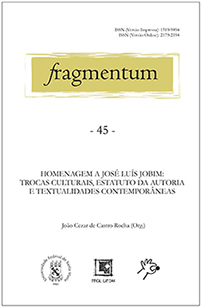ORESTES, HAMLET AND THE INFAMOUS CONSTITUTION OF THE JURY
DOI:
https://doi.org/10.5902/20735Keywords:
tragic, infamy, jury, cinema, theater.Abstract
The jury was revisited from a study on the tragic content and the creation of the infamous as a person wronged by a subordinate status through reinterpretations of the plays The Eumenides (458 BC) by Aeschylus, and Hamlet (1599-1601) by William Shakespeare. We held a confrontation between the noble characters of these plays, Orestes and Hamlet, and the subordinate personality of the (unnamed) young man tried in the movie 12 Angry Men (1957), directed by Sidney Lumet, supported in studies by Michel Foucault in Truth and juridical forms and writings by Giorgio Agamben in Profanations. We identified that classic tragedy, for pointing out the birth of the jury, promotes a trial affected by power relations that institute different measures for different offenders, which causes some conflict regarding the constitution of the concept of infamy. On the other hand, baroque tragedy has the need of the suspect’s confession as a prerogative to legitimize revenge, and such legitimacy promotes a new view on the infamous condition of the tried man. Finally, the movie by Sidney Lumet conceives the failure of justice, which delegates the convicting power to those who “know little or nothing” about the legal codes. Therefore, they are influenced by their idiosyncrasy and their own performative enactment of the court. The three works end up discussing, in different ways, many forms to understand infamous aspects with the image of the jury.
Downloads
References
AGAMBEN, Giorgio. O autor como gesto. In: ______. Profanações. Tradução e Apresentação Selvino José Assmann. São Paulo: Boitempo, 2007.
ARISTÓTELES. Diferentes espécies de poesia segundo os objetos imitados. In: ______. Arte Retórica e Arte poética. Rio de Janeiro: Ediouro, 2000.
BENVENISTE, Emile. O Vocabulário das Instituições Indo-européias: Poder, Direito, religião. V. 2. Tradução D. Bottmann. Campinas: UNICAMP, 1995.
DOSTOIÉVSKI, Fiódor. Crime e Castigo. Tradução Luiz Cláudio de Castro. Rio de Janeiro: Ediouro; São Paulo: Publifolha, 1998.
ÉSQUILO. Eumênides. In: ______. Oréstia: Agamêmnon, Coéforas, Eumênides. Tradução do Grego, introdução e notas de Mário da Gama Kury. 8. ed. Rio de Janeiro: Zahar, 2010.
FOUCAULT, Michel. A verdade e as formas jurídicas. Tradução Roberto Cabral de Melo Machado e Eduardo Jardins Morais. Rio de Janeiro: NAU, 2002.
______. A vida dos homens infames. In: ______. O que é um autor? Lisboa: Passagens. 1992. p. 103-104.
GOETHE, Johann Wolfgang. Fausto: Quadro V, Cena I. Tradução Antônio Feliciano de Castilho. Clássicos Jackson. v. 15. Aveiro-Portugal: Universidade de Aveiro; W. M. Jackson, 1956.
LUMET, Sidney. Doze homens e uma sentença. Roteiro: Reginald Rose. Drama. Estados Unidos, 96 min., 1957. Disponível em: . Acesso em: 01 out. 2015.
SHAKESPEARE, Willian. Hamlet. Tradução F. Carlos de Almeida Cunha Medeiros e Oscar Mendes. São Paulo: Virtualbooks; M&M, 2000.
Downloads
Published
How to Cite
Issue
Section
License
Ficam concedidos a Fragmentum todos os direitos autorais referentes aos trabalhos publicados. Os originais não devem ter sido publicados ou submetidos simultaneamente a outro periódico e não serão devolvidos. Em virtude de aparecerem nesta revista de acesso público, os artigos são de uso gratuito, com atribuições próprias, em aplicações educacionais e não comerciais.



